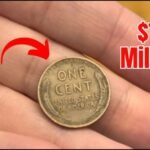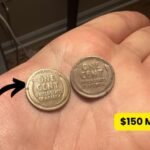Let’s face it—most of us don’t give a second thought to the small copper coins rattling around in our pockets or piling up in a jar by the door. They’re often dismissed as useless change, something to be dropped in tip jars or left behind in couch cushions. But what if one of those little coins—specifically, a humble Lincoln Wheat Penny—could actually be worth millions?
It might sound like something out of a movie, but it’s not. In fact, one version of the Lincoln Wheat Penny is rumored to be worth an astounding $21 million. Yes, $21 million for a single penny. The kicker? It might still be in circulation today.
Let’s dive deep into what makes the Lincoln Wheat Penny such a hidden gem in the world of numismatics (coin collecting), and why collectors and treasure hunters alike are scouring their spare change hoping to strike it rich.
The Birth of the Lincoln Wheat Penny: A Cent That Changed History
Introduced in 1909, the Lincoln Wheat Penny marked a major turning point in U.S. coinage. It was the first coin ever to feature a real historical figure—none other than President Abraham Lincoln. Up until that point, American coins generally depicted abstract figures like Lady Liberty. The Lincoln Wheat Penny was something different. It felt personal, patriotic, and symbolic.
Designed by Victor David Brenner, the coin’s obverse (front) displays a dignified profile of Lincoln, while the reverse (back) showcases two elegant stalks of wheat encircling the words “ONE CENT.” This distinctive wheat design gave rise to its enduring nickname: the Lincoln Wheat Penny.
Minted from 1909 to 1958, these coins aren’t just pieces of currency—they’re miniature time capsules. They were present through the Great Depression, two World Wars, and countless moments in American history. And while millions were produced, certain rare versions are what make this penny truly legendary.
What Makes the Lincoln Wheat Penny So Valuable?
Most Lincoln Wheat Pennies are only worth a few cents over face value—maybe a couple of dollars if they’re in good condition. But a few extremely rare versions have reached astronomical values at auctions and among private collectors.
So, what pushes a penny’s worth from one cent to $21 million? It comes down to three major factors:
1. Minting Mistakes
Errors during production are goldmines—figuratively speaking—in the world of coin collecting. If a coin is struck on the wrong type of metal, has a double die, or any other oddity, it instantly becomes desirable. Minting errors make the coin unique, and rarity drives up value.
2. Limited Editions or Low Mintage
Certain versions of the Lincoln Wheat Penny were only made in very small quantities. For example, some specific mint marks from particular years had limited runs. The fewer that exist, the more collectors want them.
3. Historical Significance
Coins minted during pivotal times—like war periods—are especially interesting to collectors. Add in a fluke like a minting error during such a moment, and you’ve got a coin that could be worth a fortune.
One coin that checks all three boxes? The fabled 1943 Copper Lincoln Wheat Penny.
The $21 Million Lincoln Wheat Penny: A World War II Error
During World War II, copper was considered a strategic resource, vital for manufacturing ammunition and military equipment. To conserve copper, the U.S. Mint made a switch in 1943, producing pennies out of zinc-coated steel. These coins are easy to spot—they’re silver in color and have a distinctive look.
However, a few copper blanks, or planchets, were accidentally left in the minting machines. These blank copper discs made their way into the production line and were struck with the 1943 Lincoln Wheat Penny design. This rare error resulted in a handful of 1943 Lincoln Wheat Pennies being minted in copper rather than steel.
These copper 1943 pennies are not only rare—they’re the holy grail of coin collecting. One of these elusive coins has been valued as high as $21 million, especially in mint or near-mint condition. The most exciting part? Experts believe at least one of these high-value coins is still out there, floating through circulation, lost in a change jar, or tucked away in an attic.
How to Identify a Rare 1943 Copper Lincoln Wheat Penny
So now you’re probably wondering—could you be holding onto one of these extremely valuable coins without even knowing it? Here’s a quick guide to help you identify a genuine 1943 Copper Lincoln Wheat Penny:
- Check the Date: Look for 1943 on the front of the coin.
- Examine the Color: Most 1943 pennies are steel (silver-colored). If yours is copper or bronze-colored, take a closer look.
- Magnet Test: Use a simple magnet. Steel pennies will stick to it. Copper ones won’t.
- Inspect the Details: Authentic 1943 copper pennies will have clean, unaltered numbers and lettering. Watch out for fakes made by altering 1945 or 1948 coins to look like 1943.
- Get It Authenticated: If your coin checks all the boxes, take it to a professional coin grading service for authentication. Only then will you know for sure.
Other Lincoln Wheat Pennies Worth Big Bucks
While the 1943 Copper Lincoln Wheat Penny steals the spotlight, there are several other valuable versions worth keeping an eye out for:
1. 1909-S VDB Lincoln Wheat Penny
This coin is one of the rarest in the series. Only 484,000 were ever minted in San Francisco with Brenner’s initials (V.D.B.) on the reverse. Value: Over $100,000 in excellent condition.
2. 1955 Double Die Lincoln Wheat Penny
This error coin features doubled lettering and numbers due to a die misalignment. It’s visually striking and highly collectible. Value: Up to $50,000.
3. 1922 No D Lincoln Wheat Penny
Due to a worn die, some 1922 pennies minted in Denver were released without a visible “D” mint mark. These can be worth several thousand dollars, depending on their condition.
4. 1944 Steel Penny
The opposite of the 1943 copper error, this time a few steel planchets were mistakenly used in 1944 when the mint had returned to copper. These are extremely rare and valuable, fetching tens of thousands at auction.
Why the Lincoln Wheat Penny Still Captivates Collectors
What makes the Lincoln Wheat Penny series so enduring is its blend of historical significance, wide availability, and hidden rarities. It represents over five decades of American history and was part of daily life for millions. But beyond its sentimental value, the chance of uncovering a rare variant makes it a thrilling pursuit for collectors and casual coin hunters alike.
These coins are a gateway to numismatics for many collectors. They’re relatively easy to find in antique shops, estate sales, or even your own pocket change. But every once in a while, a common-looking penny can turn out to be a million-dollar discovery.
Tips for Beginners: How to Start Collecting Lincoln Wheat Pennies
If this story has inspired you to start checking your change more carefully, you’re not alone. Here’s how to start your journey into Lincoln Wheat Penny collecting:
- Gather Your Pennies: Start by collecting any penny minted before 1959. These are all Wheat Pennies.
- Get a Collector’s Folder: Organize your finds by year and mint mark.
- Do Your Research: Learn to identify rare dates, errors, and valuable variations.
- Visit Coin Shops and Shows: You’ll meet experienced collectors and get hands-on exposure.
- Join Online Forums or Groups: Communities like r/coins on Reddit are full of knowledgeable enthusiasts eager to help new collectors.
The Final Word: You Could Be Sitting on a Fortune
The Lincoln Wheat Penny proves that even the smallest, most overlooked objects can hold incredible value. Whether it’s a $100,000 1909-S VDB or the legendary $21 million 1943 copper penny, these little pieces of history have the power to change lives.
So before you dump that jar of change into a coin machine or ignore the pile of pennies on your nightstand, take a closer look. That unassuming Lincoln Wheat Penny might just be your ticket to a life-changing discovery. Happy hunting!
Some Important Link
| Telegram Group | Click Here |
| WhatsApp Group | Click Here |
| Home Page | Click Here |




